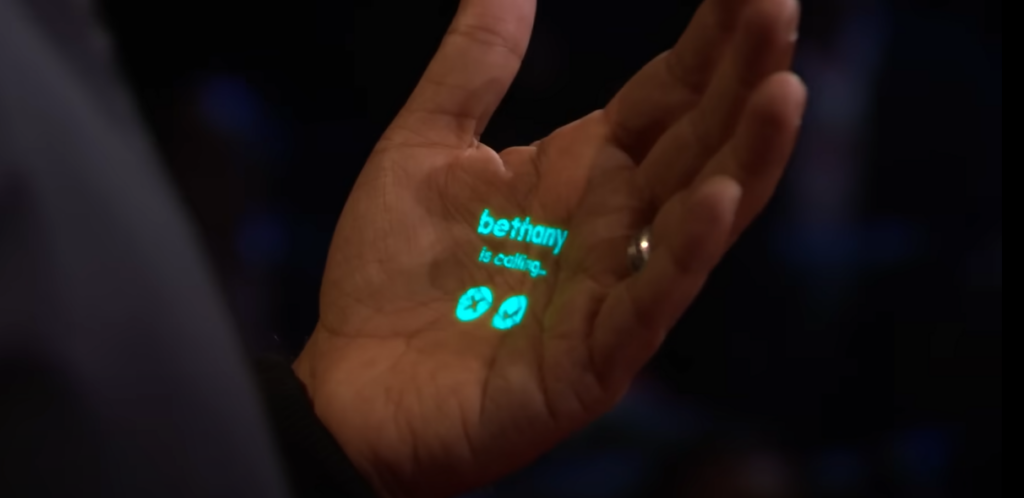
The future of AI lies on your hand says Humane. (Source – Shutterstock)
The future in the palm of your hand: Demystifying Humane’s Ai Pin
- Humane’s Ai Pin encapsulates the evolution from basic wearables to the forefront of AI fashion tech.
- The Ai Pin promises a blend of style and AI, setting a new paradigm in wearable interactions.
Wearable technology has seen an awe-inspiring transformation from its early beginnings to current iterations. This transformative path showcases fast-paced innovations and ever-growing incorporation into our daily routines. As we edge closer to realizing AI’s full potential and future, understanding the marvel of Humane’s Ai Pin requires a look back at the evolution of wearables.
Wearables from yesteryears
Our journey starts with simple gadgets like digital watches from the ’70s and ’80s. Essential as they might appear now, these devices were groundbreaking in their era, offering functionalities beyond just timekeeping, like calculator watches.
Fast forward to the late 2000s and early 2010s when fitness trackers took the stage, companies like Fitbit and Jawbone tapped into rising public interest in health metrics, from counting steps to monitoring sleep patterns. This phase underscored how technology could become a fundamental part of daily life.
Then, the game-changers arrived: smartwatches and AR technology. Devices like the Apple Watch, Samsung’s Galaxy Watch, and Google’s Wear OS blurred the lines between phones and wearables. These gadgets managed calls, texts, and apps, broadening wearables’ horizons. Concurrently, AR glasses like Google Glass marked a new era, albeit facing adoption hurdles due to privacy and design issues.
As time has progressed, technology has surpassed our wildest imaginations, transforming concepts that once seemed fantastical into fashionable realities. Major brands have partnered with haute couture houses to design wearables that merge functionality with high-end style. The goal has evolved from mere utility to producing devices that wearers are eager to flaunt rather than use out of necessity.
Introducing Humane Ai Pin
However, the wearable tech storyline took an intriguing twist with Humane’s cryptic unveiling of its ” connected and intelligent clothing-based wearable, ” the Ai Pin. It’s not just another wearable; it defies traditional notions of how we interact with tech. Instead of a quick look at one’s wrist or through a pair of glasses, this device projects data right onto a user’s palm. This groundbreaking, AI-driven device, boasting laser projection, seeks to liberate us from the shackles of our mobile devices, positioning itself as an independent digital companion.
As reported by Inverse, there’s still a shroud of mystery surrounding it, but the hope is for the fog to clear by October 14, 2023 — the solar eclipse date.
In a recent upload to Humane’s official Discord channel, the company’s chairman and president, Imran Chaudhri, and its co-founder and CEO, Bethany Bongiorno, provided a sneak peek into what’s next for this palm-projecting device.
Chaudhry was excited, saying, “Can’t wait to show you more in just a couple of months. There’s an incredible celestial event that’s happening in October, an eclipse. Eclipse is an important symbol for us. It’s a new beginning. That’s what it means. And it’s something that the whole world notices and comes together, and we certainly look forward to having a special moment on that day.”

Receiving a call from the palm of your hand with Humane’s Ai Pin. (Source – YouTube)
Bongiorno chimed in, highlighting the escalating buzz surrounding their innovation, noting that the project is now nearing completion.
Humane’s affinity for eclipses is undeniable. Chaudhri introduced the Ai Pin (without revealing its name) during a TED talk on April 20, coinciding with a hybrid solar eclipse. The October 14th announcement neatly aligns with the company’s earlier intentions to kickstart orders later in the year.
Offering his take, Sam Sheffer, who spearheads the company’s new media initiatives, commented on the device’s exceptional craftsmanship, especially its cool laser feature. He elaborated, “Having a laser project UI from your chest into your hand is inherently unique compared with the devices we all have and use today. It’s something we think is a viable way to interact with ephemeral interface elements.”
Lasers, fashion, and the future of AI: Integrating advanced technology
Laser projection technology is not entirely new, but it’s been experiencing rapid advancements in recent years. At its core, it uses lasers as a light source to project images onto surfaces. Here’s why it’s captivating:
- Brightness and clarity: Lasers provide a consistent light source, allowing for brighter and sharper projections, especially in ambient light conditions.
- Color accuracy: Laser projections can reproduce a wider color gamut more accurately than traditional bulb projectors.
- Longevity: Laser light sources have a longer operational life, often outlasting traditional bulbs. This means fewer maintenance intervals and reduced costs over time.
- Energy efficiency: Lasers consume less power and produce less heat, making them more energy-efficient and environmentally friendly.
Integrating laser projection technology with wearables is forging new paths in personal technology. One of the most compelling advantages is the potential for on-the-go displays. Given the limited screen space of devices like smartwatches, the ability to project data onto any surface offers a dynamic solution. This expands the scope for intricate data visualization, multimedia experiences, and interactive user interfaces.
In healthcare, technology promises to assist the visually impaired by projecting enhanced visuals of their surroundings. From a fashion standpoint, envision apparel that looks good and can dynamically project information or designs, adapting patterns according to the wearer’s mood or the ambient environment.
Moreover, the world of gaming and entertainment stands to gain immensely. Augmented reality games, for instance, could leverage wearable laser projections, constructing real-time interactive environments, thereby elevating the gaming experience.
The buzz surrounding Humane’s Ai Pin is palpable. Part of the enthusiasm stems from Chaudhri and Bongiorno’s history—they’re both Apple alumni who contributed to the iPhone, iPad, and Apple Watch, among other iconic products. Add Ken Kocienda, another former Apple contributor and the brains behind the iPhone’s original autocorrect keyboard, into the mix, and the intrigue only deepens. Additionally, Humane’s vision with the Ai Pin to address tech addiction and promote real-world interaction resonates with many.
During his TED presentation, Chaudhri showcased how the independent Ai Pin—no phone link needed—could diminish our phone dependency. With the power of AI, it serves as a virtual aide, condensing crucial emails, rendering real-time voice translations, analyzing food tags, and beyond.
The demonstration was nothing short of dazzling. It’s almost too dazzling.
Humane’s AI potential challenges
Humane’s Ai Pin aspires to reshape the confluence of fashion and tech. With its capability to project an interface directly onto the user’s palm, the device sets the benchmark for modern wearables, merging aesthetic appeal with unparalleled functionality. The challenge lies in integrating the Ai Pin seamlessly into daily wear. While it should ideally blend into the user’s attire as a fashionable accessory, its primary tech function mustn’t be compromised to project precise, readable data onto the hand.
The design challenge here would be to ensure that the Ai Pin seamlessly integrates into daily attire without being obtrusive, all while maintaining its core functionality. The balance is crucial; while it should look sophisticated, it shouldn’t compromise on its practical use—projecting precise, readable data onto the hand.
Another consideration is the attachment mechanism. There’s also speculation about using magnets; if so, these must be strong enough to ensure stability but subtle enough to maintain a sleek design profile.
Is it also safe to consider that Ai Pin could come naturally with their potential hardware challenges? It’s possible – especially with the battery life. For a device promising to reduce dependency on phones or smartwatches, its battery must be robust enough to support a user throughout their day.
Given that laser projection technology is energy-efficient, it offers a promising avenue. However, the device’s likely compact size and array of capabilities—from real-time translation to scanning food labels—ensuring it can handle such functionalities without frequent charging presents a significant challenge.
The longevity of the laser light source, though advantageous for reducing maintenance, further compounds this battery challenge, as users expect consistent performance over extended periods.
Privacy in the future of AI: Balancing tech and discretion
With AI capabilities embedded in the Ai Pin, concerns about data privacy inevitably surface. Given that the device can act as a personal assistant, summarizing crucial emails and notifications, it has access to sensitive and personal data. Thus, ensuring end-to-end encryption and robust security measures is paramount.
The user would need reassurance that their data isn’t vulnerable to breaches or unauthorized access. Another concern would be visual privacy. As the device projects onto the user’s palm, it might unintentionally display private information in public settings. Features like intuitive privacy settings, which can detect when the user is in public and limit the projected notifications, could be pivotal.
Nevertheless, Humane remains somewhat tight-lipped about certain aspects. The price of the Ai Pin is still a mystery. The company hasn’t divulged specifics about how the device fastens to apparel, with magnets being the widespread speculation. The device’s battery longevity remains undisclosed; for it to truly replace phones or smartwatches, its endurance must be commendable. A multitude of questions still hangs in the balance.

@WesRothMoney tweeted about how Humane’s Ai Pin will replace smartphones. (Source – X)
The progression of wearable technology underscores a consistent trend: a journey from mere convenience to integration, then to a symbiotic relationship with fashion, and now, with Ai Pin, a step towards more instinctual, human-centric interactions. As the wearables landscape evolves, observing how devices like Ai Pin shape the next chapter will be fascinating.
READ MORE
- Safer Automation: How Sophic and Firmus Succeeded in Malaysia with MDEC’s Support
- Privilege granted, not gained: Intelligent authorization for enhanced infrastructure productivity
- Low-Code produces the Proof-of-Possibilities
- New Wearables Enable Staff to Work Faster and Safer
- Experts weigh in on Oracle’s departure from adland


